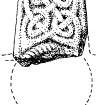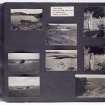Pricing Change
New pricing for orders of material from this site will come into place shortly. Charges for supply of digital images, digitisation on demand, prints and licensing will be altered.
Colonsay House, Tobar Oran
Cross(S) (Early Medieval), Holy Well (Period Unassigned)
Site Name Colonsay House, Tobar Oran
Classification Cross(S) (Early Medieval), Holy Well (Period Unassigned)
Alternative Name(s) Cill Oran
Canmore ID 318214
Site Number NR39NE 3.08
NGR NR 39590 96818
Datum OSGB36 - NGR
Permalink http://canmore.org.uk/site/318214
- Council Argyll And Bute
- Parish Colonsay And Oronsay
- Former Region Strathclyde
- Former District Argyll And Bute
- Former County Argyll
Tobar Oran, a covered well, is now roofed by an old millstone. Beside it stands the "face-cross" from Riskbuie (NR49NW 8). A carved stone, 11" high by 1'1" broad lay against the wall of the house in a flower garden in 1923.
S Grieve 1923; J de V Loder 1935
Field Visit (16 April 1974)
There is now no trace of the chapel or burial ground. Several graves covered by large slabs of stone were discovered about 1935 when landscaping the lawn of Colonsay House, but nothing further is known about them or about the cist found in 1846. The carved stones, from several sites on Colonsay, which lay against the house wall, were lost during building alterations.
Tobar Oran is a circular stone-lined well with steps leading down to the water. The cross is still beside it.
Surveyed at 1:2500.
Visited by OS (DWR) 16 April 1974
Field Visit (May 1977)
In the loggia and the gardens to the SW of the house there are several stone fragments which have been collected from various parts of the Colonsay estate, including Cill Chaitriona (NR49NW 1). These include a cross-fragment of Early Christian date.
Tobar Odhrain.
This well, which is evidently dedicated to St Oran, is situated within the garden of Colonsay House (NR39NE 3.00) about 90m E of the main block of the house. The well-chamber which is approached from the NNE by a short flight of stone steps, is about 0.6m in diameter and approximately 1m in height over all. It is constructed of coursed and mortared rubble masonry and is capped by a runner millstone measuring 0.75m in diameter and 0.1m in maximum thickness; a stone fragment shaped by natural weathering has been placed above the eye of the millstone. A cruciform stone (see NR49NW 8.01) of Early Christian date from Riasg Buidhe has been re-erected immediately E of the well.
RCAHMS 1984, visited May 1977
Field Visit (October 1981)
(NR 394 867) Part of the tapered arm of an Early Christian free-standing cross of unknown provenance lies on a terrace in the private garden immediately SW of Colonsay House. The fragment, which is much worn, is of epidotic schist, probably of local origin, and measures 0.37m by 0.33m. It bears in low relief part of a cable-moulding which has encircled the centre of the cross-head, and the arm contains interlaced knot (Allen and Anderson 1903, 220, fig. 435a) with pointed terminals. This interlaced pattern is found on carvings of Early Christian date at Farnell, Angus, and Abercorn, West Lothian (RCAHMS 1929, fig. 212), and a cable moulding in the sarpe position occurs in conjunction with tapered arm of similar dimensions on the cross-slab at Soroby, Tiree (RCAHMS 1980, 168).
RCAHMS 1984, visited October 1981.
Reference (2001)
Built on the supposed site of the parish church of Kiloran, and a cist-burial was found in 1846 (Martin 1934; Name Book 1878). In the loggia is a tapered cross-arm of unknown provenance, 0.37m by 0.33m. It bears interlaced knots (RA 658) with pointed terminals, and part of a cable-moulding which encircled the centre of the cross-head.
I Fisher 2001.












